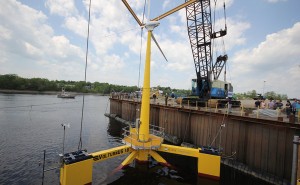
The VolturnUS. Image credit New York Times
Wind energy has been in use for centuries; Christopher Columbus certainly didn’t use coal to make his journey. Even though wind power isn’t commonly used for commercial vessels, we can all picture a wooden boat with billowing sails, rushing through the sea. Now wind energy is returning to the waves with the floating turbine that was recently launched in Maine.
The Volturn US
Unfortunately, this particular turbine isn’t vertical, but it’s still fairly innovative. The 65 foot VolturnUS is just a prototype; it’s only 1/8th of the planned size for the final turbine. The tower floats on three hollowed-out concrete tubes, which help provide stability on the rocky waves. At it’s current size, this turbine can generate 20 kilowatts of power, but the larger version should be able to generate 6 megawatts.
According to the Department of Energy, the Volturn is one of seven turbines that are currently being developed. The goal is to explore the possibilities of off-shore energy, which could result in over 4,000 gigawatts of energy potential.
Why OffShore?
If a turbine was moving at full speed every second of every day, it would generate immense amounts of energy. Unfortunately for turbines (but fortunately for the rest of us), the wind isn’t constant and heavy. Currents change and move, and wind patterns are never steady. This means that land turbines usually only generate about a third of the power they could be if they had a steady supply of airflow.
The sea, however, is an entirely different matter. In the Gulf of Maine, where the Volturn is being anchored, there’s a steady, predictable breeze every morning. The rising sun heats the air over the land, while the sea keeps the air above it fairly cold. This change in temperature causes a strong – and more importantly, regular – breeze that can be easily tapped.
The biggest problem with offshore turbines has been the difficulty in constructing them. It’s incredibly to build a strong foundation underwater, especially once you get farther out and the land below drops away. Likewise, floating turbines have the possibility of being toppled by waves – something the VolturnUS is hopefully prepared against.
Of course, offshore wind farms aren’t particularly new; Europe has had them for quite some time. 22 of the worlds largest offshore wind farms are located in Europe, and there are countless other small groups of turbines. The United States may be a little behind, but that doesn’t change the fact that the possibility of taking our turbines off the land and putting them into the water could make wind energy a lot more viable.

Comments are closed